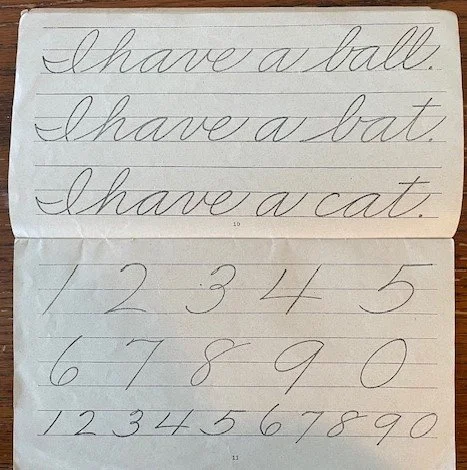Page from the Zaner-Bloser Correlated Handwriting Compendium by Frank N. Freeman, 1936.
Since humans began writing on papyrus, that writing has been done by hand. Only in the last few decades has most writing changed to typing on a typewriter or computer. In this digital age, there seems to be no more need for writing by hand, much less the more challenging cursive writing, yet recent developments are bringing handwriting back.
According to Nathaniel Cerf of ThePenMarket.com, cursive writing, as we recognize it today, was developed in Europe in the 16th century.[1] With cursive writing, connecting the letters of each word made handwriting faster. However, with more people becoming literate in the 19th century, penmanship became increasingly important. In the 1840s, Platt Rogers Spencer developed a variation of cursive, the Spencerian method, that became the dominant style of writing for important documents through the 1920s.[2] However, Spencer’s cursive was difficult to master so by 1888 it was replaced by the Zaner-Bloser method, developed by Columbus, Ohio business partners Charles Paxton Zaner and Elmer Ward Bloser, and remains the most common style today.[3]
Common Core education standards removed cursive writing in 2010 because of the perception that typing was the future of writing. For a host of reasons, cursive is making a comeback. “Experts say learning cursive improves cognitive development, reading comprehension and fine motor skills, among other benefits. Some educators can also find value in teaching children to read historic documents and family letters from generations past.”[4] A recent study in the journal Frontiers in Psychology also found that the brain is highly active when writing by hand compared to typing. Handwriting engages the whole brain while typing barely taxed the brain at all. While not conclusive, the study suggests writing by hand offers cognitive benefits, especially for older adults and students with dyslexia.[5]
Cursive handwriting is making a comeback with the State of California becoming the 22nd state to reinstate cursive handwriting back into the elementary school curriculum this year. Five more states are considering returning cursive to their schools in 2024 according to Reuters.[6] Not that long ago, cursive was thought to be going extinct. The mandatory handwriting standard in schools for centuries may have benefits that were not realized with the onslaught of new technologies.
During your next visit to the Sholes School Museum in St. Charles, try writing cursive on a slate as students would have over 150 years ago!
Thank you for reading! If this story interested, inspired, or informed you, please consider subscribing to our monthly e-newsletter so more of these stories come right to you!
[1] Nathaniel Cerf, “A Brief History of Cursive Writing,” ThePenMarket.com, August 27, 2014, https://www.thepenmarket.com/vintage-pens-blog/2014/08/a-brief-history-of-cursive-writing/.
[2] Ibid.
[3] “More Than Just a Handwriting Company,” History, Zaner-Bloser, https://www.zaner-bloser.com/company/history.php.
[4] Daniel Trotta, “Shunned in Computer Age, Cursive Makes a Comeback in California,” January 27, 2024, https://www.reuters.com/world/us/shunned-computer-age-cursive-makes-comeback-california-2024-01-27/.
[5] Aria Bendix, “Writing by Hand May Increase Brain Connectivity More than Typing, Readings of Student Brains Suggest,” NBC News, January 27, 2024, https://www.nbcnews.com/health/health-news/writing-by-hand-may-increase-brain-connectivity-rcna135880.
[6] Trotta, “Shunned in Computer Age.”

